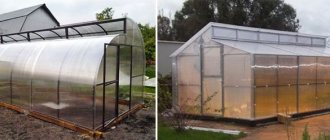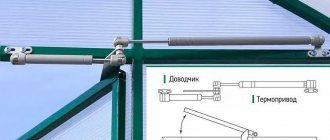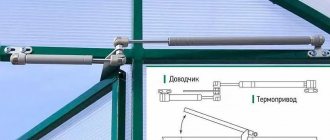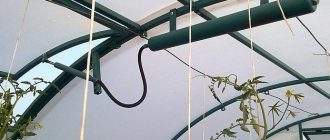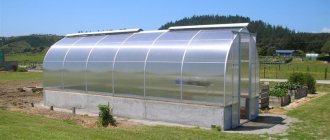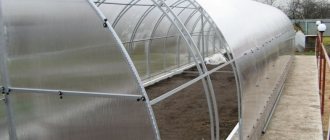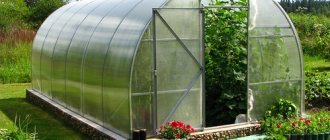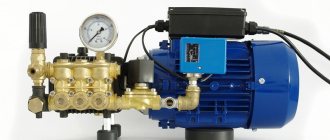Quite a number of devices have been developed that can respond to temperature changes in space, from the simplest to the most sophisticated. However, many summer residents do not trust homemade products with such an important task as ventilation - if the mechanism does not work at some point, the crop will burn or freeze, and months of hard work will be in vain. Are there reliable automatic vents for greenhouses that can reliably control the microclimate and thereby relieve the owners of routine responsibilities?
Automatic window in a greenhouse
Thermal drive operating principle
Regardless of the design of the thermal drive, the essence of its operation is to open the window leaf when the temperature rises. When the air in the greenhouse cools down, the thermal drive automatically closes the window to its original position.
There are two main elements in the device:
- sensor;
- actuating mechanism.
Moreover, the design of the sensors and actuators themselves can be completely arbitrary. Additionally, the devices can be equipped with closers and locks that ensure tight closure of the transom.
There is also a division into volatile and non-volatile devices . Electric drives operating from the power supply network most often act as volatile drives.
Their advantages include greater power and wide possibilities for programming behavior.
The disadvantages are that if there is a loss of electricity supply, there is a risk of either chilling the plants due to the window being left open at night, or cooking them on a hot day when the ventilation is not opened.
Classification of greenhouses with automatic ventilation
To do this, it is necessary to install: automatic vents for the greenhouse, working in conjunction with other devices included in the forced ventilation system (thermal sensors, fans, and so on). All greenhouses with automatic ventilation are divided into three main categories:
- Autonomous systems.
- Automated systems.
- Non-volatile.
Let's take a closer look:
- The first option is the simplest and cheapest. To implement it, it is necessary that automatic vents for greenhouses be installed.
- The second option is more complex and requires the interaction of all components of the ventilation systems. But to install a non-volatile ventilation system, it is necessary to install a backup power source.
Note. Each of these systems has its pros and cons; if the main advantages of the first are its ease of manufacture and low price, then it should be taken into account that it is suitable mainly for small summer cottages and individual households.
- An automatic greenhouse window opening machine can be installed both on small structures and on entire greenhouse complexes.
This is due to its ease of use and high technology, but it has a very significant drawback - a failure in the power supply can cause irreparable harm to the plant or even their complete death.
Advice. Therefore, for large greenhouse farms, the arrangement of energy-independent ventilation systems can be considered a priority.
Vents for automatic opening of greenhouses
Types of structures
Regardless of which ventilation system is chosen, they all have one common characteristic detail. These are windows for automatic greenhouses. They can have different fundamental designs and devices. Automatic window openers for greenhouses are of the following types:
- Bimetallic
- Pneumatic
- Hydraulic
- Electrical
Note. In addition, the automatic opening of vents in a greenhouse can be carried out according to various preset parameters, for example, at a precisely set time, according to certain temperature indicators.
Scope of application
Where can you install a thermal drive for greenhouses with your own hands?
Installation of thermal drives (photo on the right) can be done on absolutely any greenhouses : film, polycarbonate and glass.
In the latter case, the choice of drive must be approached especially carefully , since the glass window has a significant mass and working with it may require a fairly powerful device.
In addition, the size of the greenhouse matters . There is little point in installing such a device in a greenhouse with an area of one and a half square meters. m. There simply is not enough space here, and the frames of such structures are most often not able to bear the additional load.
In very large greenhouses some problems may also arise. This is due to the need to simultaneously open several windows at once, often also differing in considerable size. The power of a homemade thermal drive is simply not enough to do such hard work.
most harmoniously into the design of greenhouses made of cellular polycarbonate. Windows made from this material are light enough that even a homemade device can operate them. At the same time, polycarbonate is reliable enough to make a durable window suitable for repeated opening and closing cycles.
Peculiarities
Dachas equipped with greenhouses have always pleased their owners with a large harvest. In winter, in polycarbonate greenhouses, the most popular at present, the conditions for keeping plants are optimal. But with increasing solar activity in spring and summer, the situation changes.
Polycarbonate transmits light very well, but at the same time does not allow air to circulate.
The temperature in the greenhouse becomes too high and can have a detrimental effect on the plants grown in it. Therefore, in such a design the window is especially important.
The movable part of the greenhouse intended for ventilation is called a window. This device allows you to create your own microclimate in the greenhouse, which has a beneficial effect on the cultivation of various types of vegetable crops.
Execution options
Based on their mechanism of action, there are several main groups of thermal actuators. How to arrange automatic opening of vents in a greenhouse with your own hands?
Electrical
As the name suggests, in these devices the actuator is driven by an electric motor . The command to turn on the motor is given by the controller, which relies on information from the temperature sensor.
The advantages of electric drives include greater power and the ability to create programmable intelligent systems that include a wide variety of sensors and allow the most correct determination of the greenhouse ventilation mode.
The main disadvantages of electric thermal drives are their dependence on power supply and not the lowest cost for a simple gardener. In addition, the humid atmosphere of the greenhouse is not conducive to long-term operation of any electrical appliances.
Bimetallic
The principle of their operation is based on different coefficients of thermal expansion for different metals. If two plates of such metals are somehow fastened together, then when heated, one of them will certainly become larger in size than the other. The resulting distortion is used as a source of mechanical work when opening the window.
The advantage of such a drive is its simplicity and autonomy, the disadvantage is that it does not always have sufficient power.
Pneumatic
The operation of pneumatic thermal actuators is based on the supply of heated air from a sealed container into the actuator piston . When the container heats up, the expanded air is fed through the tube into the piston, which moves and opens the transom. As the temperature drops, the air inside the system compresses and pulls the piston in the opposite direction, closing the window.
Despite the simplicity of this design, it is quite difficult to make it yourself. It will be necessary to provide a serious seal not only to the container, but also inside the piston. The problem is also complicated by the ability of air to be easily compressed, which leads to a loss in the efficiency of the entire system.
Hydraulic.
The hydraulic thermal drive mechanism is driven by a change in the balance in the weight of a pair of containers between which the liquid moves. In turn, the liquid begins to move between the vessels due to changes in air pressure during heating and cooling.
The advantage of hydraulics is its relatively high power with complete energy independence. In addition, assembling such a structure with your own hands is much easier and cheaper than for other drives.
How to independently organize automatic ventilation of greenhouses (thermal drive, which one to choose)?
Master classes on the construction of automatic vents
Automatic devices for opening greenhouse vents are good because they work without an energy source. This is important for those who do not want to run a network into the greenhouse or install batteries. However, among the variety of schemes developed by specialists and tested in practice, choosing the best option for how to make a window in a greenhouse that opens automatically is quite possible.
Secrets of arranging a hydraulic opener
Water and air react relatively quickly to temperature changes, and this property came in very handy in the homemade design of the opener, which operates on hydraulics. Its arrangement is simple and does not require additional costs, since almost all components can be found in any garage or shed.
Despite its simplicity, the design below, with proper adjustment, can work for several seasons, and maintenance consists of draining the water for the winter. For construction you need:
- tin containers of different sizes (paint cans are quite suitable);
- two copper or aluminum tubes with a diameter of 5 mm and such a length that they reach the bottom of the containers and leave a protruding end of 5–7 cm;
- any liquid - water, antifreeze, engine oil, including used;
- a tube from a dropper with a length of at least 1 m;
- sealant for external use and fasteners for containers.
Option – with plastic bottles
One of the tin cans serves as a kind of thermometer, and the larger one serves as a weighting agent for the moving edge of the window.
- The first jar must be placed in the greenhouse, and the second can must be placed outside, attached to the window frame.
- The lids of both containers should be hermetically sealed and a 4 mm hole should be drilled into them.
- Insert a metal tube inside (10 mm from its end to the bottom), then seal the joints.
- Using a watering can, pour liquid into both jars (the amount must be determined experimentally) and connect them with a flexible tube.
- Having completed these manipulations, secure both containers to the frame of the greenhouse and to the frame of the window.
The air expanding when heated will displace water or oil into another tank, which, due to the increase in weight, will lift the opposite edge of the window upward. When it cools down, the system will reverse.
Proven thermal drive design from car enthusiasts
Vehicle owners often have on hand various spare parts left over from their previous car. It is not surprising that some craftsmen thought of putting them to work by installing an automatic window opener for a greenhouse.
For example, you can use an air shock absorber from any passenger car, which is usually installed on the hood or rear doors.
A fifth door air shock absorber like this would be suitable.
The technical condition of the spare part does not matter, the main thing is that it has pressure (checked by pressing on the rod). If you have the necessary components, the device can be assembled in one or two evenings according to the following instructions:
- Carefully, avoiding deformation of the cylinder, cut off the spherical part of the shock absorber so as to leave the maximum length of the shank.
- From the cut end of the shank, observing safety precautions, drill a hole with a diameter of 2–3 mm to the internal cavity - air should come out of the cylinder under slight pressure.
- Cut a thread on the end to attach the oil reservoir.
- To make a tank, take a cardan from any car with an approximate volume of 3 liters (if the cardan is larger, it can be filled with any unnecessary parts), cut off the eyes and remove the length to 800 mm.
- Weld the end of the future oil tank and drill a hole on the other side to connect to the hose.
- If there is no cardan, you can use an old car fire extinguisher bottle instead.
- Select a brake hose from any car - the dimensions of the threads on the reservoir and cylinder depend on the parameters of its thread.
Automatic ventilator from auto parts
Before assembling the entire structure together, you need to pour oil (the cheapest - M8) into the shock absorber using a medical syringe and into the reservoir to the top. After this, you need to screw the hose to the cylinder and almost completely remove the air, leaving a small air bubble. It is recommended to install the system in a greenhouse, taking into account its parameters and the location of the transoms.
How to make a thermal drive from electricity
Mechanically, it is not always possible to ensure timely automatic opening of the window in the greenhouse, since in the spring there are often sudden temperature changes, to which the hydraulic system reacts with a significant delay.
Therefore, many summer residents install devices for forced ventilation, while simultaneously installing an electric drive for opening the window.
A completely reliable option is a homemade device consisting of several elements:
- DC electric motor - it is recommended to use a motor from the most inexpensive electric screwdriver;
- hinged pusher mechanism - performed according to the instructions below from several corners and a piece of angle steel;
- controller devices - timer, photo relay, thermometer.
Electric drive in action
First you need to design a pusher and combine it with an electric motor:
- Attach a piece of metal corner 20x20 with a length of 150 mm to the inner lower end of the window using a regular door hinge.
- At its opposite end, weld a nut with an M10 thread.
- To attach the motor, it is necessary to bend a 4x40 steel strip into a U-shaped profile so that it is placed with a small gap between its shelves, and there is at least 20 mm from the shaft to the end of the bracket.
- Drill a 10 mm hole on both edges of the resulting bracket and screw it with the appropriate bolts along a piece of angle 120–140 mm long.
- Secure the electric drive inside the U-shaped bracket by clamping its housing with screws through two threaded holes drilled on one side.
- Rigidly attach the free edges of the corners to the greenhouse frame.
- To transmit movement from the engine shaft to the pusher, it is necessary to select a pin with a length no less than the height of the window, and with an M10 thread cut at the end.
- Connect the stud and the electric motor shaft using a standard or homemade adapter coupling.
After these manipulations, all that remains is to connect the electronics according to the diagram and power the circuit from the mains through the appropriate adapter.
Connection diagram of the thermostat and timer to the electrical network
DIY making
How to make a device for ventilating greenhouses with your own hands? For self-production, the simplest and most effective thermal drive option for greenhouses is hydraulic .
To assemble it you will need:
- 2 glass jars (3 l and 800 g);
- brass or copper tube 30 cm long and 5-7 mm in diameter;
- plastic tube from a medical dropper 1 m long;
- a piece of wooden beam equal to the width of the opening transom. The cross-section of the block is selected taking into account the weight of the window, since it will be used to make a counterweight;
- rigid metal wire;
- sealant;
- two lids for jars: polyethylene and metal;
- nails 100 mm - 2 pcs.
The assembly sequence will be like this:
- 800 g is poured into a three-liter jar;
- The jar is tightly sealed with a metal lid using a seaming machine;
- a hole is punched or drilled in the lid into which a brass tube is inserted. You need to lower the tube until 2-3 mm remains to the bottom;
- the joint between the tube and the lid is sealed with sealant;
- One end of the plastic tube is placed on the metal tube.
Next, they work with a jar of 800 g, only it is left empty, closed with a plastic lid and a plastic tube is inserted at the other end. 2-3 mm is also left from the cut of the tube to the bottom of the jar.
The final stage is to place the jars at work stations. To do this, hang a three-liter bottle with a nail and a metal wire next to the rotating window so that, in any position of the window, the length of the plastic tube is enough to reach it.
A small jar is also attached to a nail and wire on the upper part of the frame of a horizontally rotating window. To balance the mass of the can, a counterweight block is nailed from the street side of the window to the lower part of its frame.
Now, if the temperature in the greenhouse rises, the air heated in the large jar will begin to squeeze water through the plastic tube into the small jar. As water is filled into the small jar, due to the increased weight of the upper part of the window, it will begin to rotate around its axis, i.e., it will begin to open.
As the air in the greenhouse cools, the air in the three-liter jar will begin to cool and compress. The resulting vacuum will draw water back from the small jar. The latter will lose weight and the window frame will lower to the “closed” position under the weight of the counterweight.
The not-so-intricate design of the hydraulic thermal drive allows you to independently assemble a device that greatly facilitates the care of the greenhouse. With its help, there is completely no need to control the air temperature in the greenhouse.
Device
The design of vents in greenhouses may differ in size, location and opening mechanism. The last characteristic is the most significant. To organize good air circulation, it is possible to use natural or forced ventilation.
In a film or glass greenhouse made independently, they usually use the simplest and cheapest way to equip the greenhouse with the correct microclimate - natural ventilation. Natural ventilation involves ensuring air exchange through open doors, windows, and vents. The overheated and humid air of the greenhouse is gradually replaced by fresher outdoor air.
Considering that hot air tends to rise, you should install a window on the roof, and the side position of the door will ensure air flow.
Such ventilation will sufficiently provide good conditions in a small greenhouse, but requires mandatory human control. However, for large greenhouses such ventilation will not be enough.
For large greenhouses, forced ventilation is provided. This ventilation is equipped with a fan. An exhaust fan is installed at the top of the structure, the power of which must be sufficient to effectively remove hot air. Devices for air flow are installed on the walls, taking into account the location of the plants. Direct flow of colder air masses can harm them. This ventilation device is most often used in addition to natural ventilation and does not exclude human control.
The complete absence of manual adjustment of the microclimate in the greenhouse can be ensured by an automatic ventilation system.
Purpose
A favorable climate can be created in a greenhouse at the dacha only by organizing ventilation. It is not enough to simply install windows; you need to do it correctly, this is the only way to prevent the appearance of microorganisms and bacteria. Forced ventilation of the greenhouse is one of the options.
A good option is polycarbonate, which allows light to pass through, but not air. A window is extremely necessary for cucumbers in winter and other crops. Most often, there are two vents so that the plants inside do not burn from the elevated temperature, but their number depends on the size of the room. Usually they organize the structure on a gable roof and other options.
There are ready-made options, or you can create it yourself using suitable tools. It is the window that contributes to the hardening of planted crops. They become more resistant to adverse conditions.
All ventilation structures can be divided into such large groups as:
- mechanical;
- automatic from shock absorber or hydraulics;
- with opening system.
Automatic polycarbonate windows are equipped with an electric drive. This option is more practical than the mechanical one, since the system reacts to rising temperatures thanks to the installed transom. Thus, the microclimate inside remains at the required level, which simplifies the process of caring for plants for the gardener.
Windows with automatic installation are as follows:
- with hydraulic system;
- electrical workers;
- based on the principles of metal compression.
You can understand which option is preferable only by assessing the advantages and disadvantages of each design.
Hydraulic
A simple system, built on built-in hydraulics, is connected to the window structure. It is reliable and autonomous. You can create a design of different power. The principle of operation is that delta measures temperature and humidity, and also decides whether it is necessary to ventilate the room.
Parameters of thermal drive models in comparison
Numerous stores selling this product in Moscow and other Russian cities offer a wide range of automatic ventilation systems for greenhouses, both domestic and foreign. Among the large number of Chinese goods, which can be under any brand of a well-known company, it is almost impossible to determine the manufacturer. Therefore, the characteristics refer only to model names.
Model "Comfort AERO"
| Force application area | door, any window |
| Amount of force developed | 100 kg |
| Operating temperature range | from -50°С to +60°С |
| Operating conditions in winter | no need to remove for winter |
| Rod travel length | maximum 90 mm |
| Trigger temperature | |
| for the opening | 23°C |
| to close | 22°C |
Model “Vent – L 001”
| Force application area | door, any window |
| Amount of force developed | 100 kg |
| Operating temperature range | from –40°С to +60°С |
| Operating conditions in winter | no need to remove for winter (at T < 18° C you cannot force open a door or window) |
| Rod travel length | maximum 10 mm |
| Trigger temperature | 23°C, adjustable. |
Model "Gigavent"
| Force application area | lifting window |
| Amount of force developed | 60 kg maximum |
| Operating temperature range | cannot be used at temperatures > 60°C |
| Operating conditions in winter | no reliable information |
| Rod travel length | 30 mm |
| Trigger temperature | 17°С–25°С, adjustable |
Model "TP - 440"
| Force application area | lifting window |
| Amount of force developed | 7 kg |
| Operating temperature range | from –50°С to +60°С |
| Operating conditions in winter | no need to remove for winter |
| Rod travel length | maximum 900 mm |
| Trigger temperature | 23°C |
Model "Dusya San"
| Force application area | lifting window |
| Amount of force developed | up to 7 kg |
| Operating temperature range | from 0°С to +50°С |
| Operating conditions in winter | not used in winter |
| Rod travel length | 100 mm |
| Trigger temperature | 15°С–25°С |
Model "UFOPAR"
| Force application area | opening doors |
| Amount of force developed | 100 kg |
| Operating temperature range | from –40°С to +60°С |
| Operating conditions in winter | no need to remove for winter |
| Rod travel length | 70 mm (angle 90°) |
| Trigger temperature | 16°С–25°С |
Design differences
The most common option in practice is the one where a liquid is used as a working fluid, which begins to expand greatly in volume at temperatures above 23°C. The device kit includes, in addition to the thermal drive, all the necessary elements for its installation:
- thermal drive assembly unit with an actuator;
- closer - a lever system that provides opening/closing of a door, window, window, greenhouse frame;
- a spring (there may be several of them), as an integral part of the closer, creating the condition for a smooth opening and using its elastic energy for closing;
- brackets for attaching to the frame of the greenhouse and the body of an object opened by a thermal drive (windows, vents, doors and other types);
- clamps for fastening the ball joints of the brackets to the ends of the thermal actuator and spring;
- fasteners, such as self-tapping screws.
In expensive versions of thermal actuators, gas springs are used instead of conventional springs, ensuring tighter and smoother closing.
We recommend reading: how a smart greenhouse can be made, automation for smart greenhouses.
Installation
If a summer resident purchases a factory-made device that will automatically open the windows in the greenhouse, then it will not be difficult to install it with your own hands, strictly adhering to the included instructions. But there are points not specified in the instructions. For example, even at the stage of constructing a greenhouse, you need to think about the location of the transoms and doors - they are not made on the same wall. The vents do not need to be located on the side from which a strong wind usually blows; it is generally better to place them on top.
Light electric machines can be mounted directly on the window, while heavier ones can be mounted on the frame elements of greenhouses. It would be good to know the weight of the device in advance and check the options for its placement. The windows need to be equipped with special tapes (ropes, chains), which will prevent them from opening too much, but will fix a certain opening angle.
All such devices depend on temperature; you need to know that it is the air temperature in the greenhouse that is measured, and not the heating of the device itself - you may need to hide the machine from direct sunlight.
Recommendations for ensuring long, trouble-free operation of the thermal drive
- Install the thermal drive in strict accordance with the instructions attached to the technical documentation for operating the device.
- When operating a thermal drive in climatic conditions with difficult wind conditions, measures should be taken to prevent the device from being destroyed by the wind. It is necessary to equip the opening sash with a limiting cable, making it impossible to open it to its maximum beyond the full extension of the operating rod of the ventilation machine.
- The opening force must be commensurate with the weight and dimensional characteristics of the vent, window, or door. With force, for example, a kilogram window will dangle even in a slight wind. All hinge joints of the structure will quickly break, and when it gets cold, such a window will not ensure tight closure against the penetration of cold air into the greenhouse. A heavily loaded window will reduce the service life of the automatic ventilator.
- The thermal drive design parts are made of corrosion-resistant materials (stainless steel, aluminum alloys and others) or coated, for example, with zinc or chromium (ventilator rod). The chrome-plated rod can be protected from dripping condensate by positioning it lower relative to the sash being opened. The condensate will flow freely without encountering any obstacles on its way.
